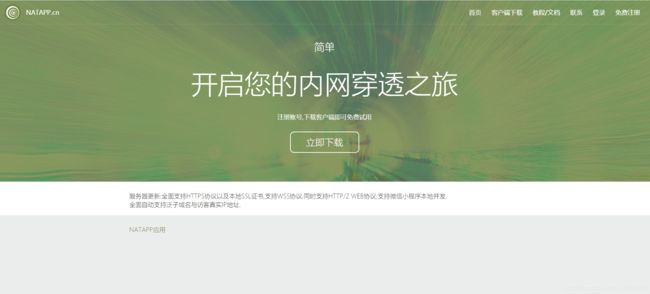vue显示二维码,微信扫描二维码获取用户的信息
微信扫描二维码获取用户的信息(网页授权)
文章目录
- 微信扫描二维码获取用户的信息(网页授权)
- 一、需求解说
- 二、步骤准备
-
- 1.内网穿透
-
- 1.1内网穿透工具natapp
- 1.2启动natapp
- 2.微信公众号测试号
-
- 2.1申请测试号
- 2.2接口配置信息
- 2.3配置微信网页授权网址
- 3.vue二维码插件(qrcodejs2 )
-
- 3.1插件安装
- 3.2插件使用
- 4.后台获取信息
-
- 4.1跳转鉴权路径
- 4.3同意授权获取access_token
- 4.4拉取用户信息
- 4.5自定义微信api请求weChatRequestGet方法
一、需求解说
在vue页面显示一个普通二维码,微信用户使用微信扫一扫功能扫描二维码,后台获取到该微信用户的用户信息
二、步骤准备
1.内网穿透
当前是开发环境,所以使用内网穿透使外网能够访问到本机的内容
1.1内网穿透工具natapp
点击进入natapp官网

注册账号 =》 登录 =》购买免费隧道
我的隧道
根据自己项目的实际情况自行配置
下载natapp客户端
1.2启动natapp
1、点击下载好的natapp.exe进入命令行界面
2、使用命令启动 natapp -authtoken=1b2d363c3a5ea50d
启动成功如下图(-authtoken=后接的是natapp隧道中对应的authtoken)

2.微信公众号测试号
2.1申请测试号
点击进入微信公众平台测试号申请页
2.2接口配置信息

url:域名+项目名+接口路径
配置规则与验证可查看网址https://developers.weixin.qq.com/doc/offiaccount/Basic_Information/Access_Overview.html
后台验证代码参考:
@RequestMapping(value = "oauth")
public void oauth(HttpServletRequest request, HttpServletResponse response) throws Exception {
System.out.println("========WechatController========= ");
Enumeration pNames = request.getParameterNames();
while (pNames.hasMoreElements()) {
String name = (String) pNames.nextElement();
String value = request.getParameter(name);
// out.print(name + "=" + value);
String log = "name =" + name + " value =" + value;
System.out.println(log);
}
String signature = request.getParameter("signature");/// 微信加密签名
String timestamp = request.getParameter("timestamp");/// 时间戳
String nonce = request.getParameter("nonce"); /// 随机数
String echostr = request.getParameter("echostr"); // 随机字符串
PrintWriter out = response.getWriter();
//判断逻辑
//判断信息正确后返回该内容,失败后不返回
out.print(echostr);
out.close();
}
2.3配置微信网页授权网址
3.vue二维码插件(qrcodejs2 )
3.1插件安装
npm install qrcodejs2 --save
3.2插件使用
页面引入
import QRCode from "qrcodejs2"
二维码生成
//dom代码
请使用微信扫描二维码
生成方法
qrCode() {
//服务器根目录访问路径,域名+项目名(供微信跳转链接使用)
let pre = "http://8jt7n4.natappfree.cc/api/";
let date = moment(new Date());
//二维码对应的链接
let url = pre +接口路径+ "?timestamp=" + date;
this.$nextTick(function () {
document.getElementById("qrcode").innerHTML = "";
let qrcode = new QRCode("qrcode", {
width: 150,
height: 150,
text: url,
correctLevel: 3
});
});
},
4.后台获取信息
4.1跳转鉴权路径
扫描二维码后进入二维码对应的接口中
//获取到教师的信息传输到跳转链接
//根据自己的实际情况进行生成跳转链接
String redirect_uri = preUrl + "WeChatManager/invoke";
//调用授权链接使微信跳转授权页
Authorization(response, redirect_uri);
private void Authorization(HttpServletResponse response, String uri) throws IOException {
//链接需要先进行utf8编码
try {
uri = URLEncoder.encode(uri, "UTF-8");
} catch (UnsupportedEncodingException e) {
e.printStackTrace();
}
//uri为同意授权后跳转的链接
//生成微信网页授权的url
String url = "https://open.weixin.qq.com/connect/oauth2/authorize?"
+ "appid=" + appId
+ "&redirect_uri=" + uri
+ "&response_type=code"
+ "&scope=snsapi_userinfo"
+ "&state=STATE#wechat_redirect";
response.sendRedirect(url);
}
4.3同意授权获取access_token
用户同意授权后将会携带code一起跳转到自定义的重定向路径中
本项目直接跳转至后台
后台接口请求获取access_token
//根据code去请求access_token和openid等信息,请求链接如下,JsonNode接收返回信息
String getTokenUrl = "https://api.weixin.qq.com/sns/oauth2/access_token?"
+ "appid=" + appId
+ "&secret=" + appSecret
+ "&code=" + code
+ "&grant_type=authorization_code";
JsonNode jsonNode = weChatRequestGet(getInfoUrl);
具体说明微信官方文档
4.4拉取用户信息
//生成获取用户信息的api链接JsonNode接收返回信息
String getInfoUrl = "https://api.weixin.qq.com/sns/userinfo?"
+ "access_token=" + access_token
+ "&openid=" + openid
+ "&lang=zh_CN";
JsonNode jsonNode = weChatRequestGet(getInfoUrl);
具体说明微信官方文档
4.5自定义微信api请求weChatRequestGet方法
private JsonNode weChatRequestGet(String url) throws IOException {
JsonNode jsonNode = null;
HttpClient client = HttpClientBuilder.create().build();
HttpGet httpGet = new HttpGet(url);
HttpResponse response = client.execute(httpGet);
HttpEntity entity = response.getEntity();
ObjectMapper mapper = new ObjectMapper();
if (entity != null) {
String result = EntityUtils.toString(entity, "UTF-8");
jsonNode = mapper.readTree(result);
System.out.println(result);
return jsonNode;
} else {
return null;
}
}


